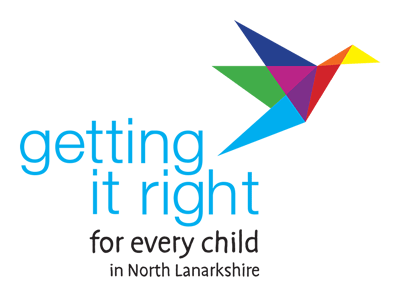Getting it right for every child (GIRFEC) is a national policy driver which seeks to make Scotland the best place for children and young people to grow up in.
The main aim of GIRFEC is to improve outcomes for all children and young people.
It is recognised that parents or carers of children and young people are the best people to ensure their child’s wellbeing is the best it can be. What is meant by wellbeing is that children will be safe, healthy, achieving, nurtured, active, respected, responsible and included. Most parents and carers usually have family and friends around them to support them to do this.
There may be times however, when they need additional help to develop their child’s wellbeing. Health professionals (health visitors) and education staff (early years staff, and teachers) have a key role to support and nurture the wellbeing of all children and young people. You, as a professional, should be able to offer advice and support or signpost them to the right person who can help them.
The GIRFEC approach ensures every child or young person will have a designated Named Person available to them. This is an identified professional whose job it is to be a first point of contact for children, parents or anyone who has a concern about a child or young person’s wellbeing.
The child or young person’s Named Person will be available to provide information, support or advice, or can help them to access, or signpost them to appropriate services when needed.
To read more about GIRFEC follow this link to the Scottish Government GIRFEC website.
Planning Pathways
In North Lanarkshire agencies have come together under GIRFEC and have agreed on a single pathway for planning and support for school age children and young people. The pathway supports agencies to work together to assess, plan and assist children, young people and their families to develop their wellbeing.
The pathway enables agencies across education, health and social work to use the Core Components of GIRFEC to ensure the most timely and proportionate support is available to children, young people and their families. The Children and Young People’s Pathway for Planning and Support encompasses three levels of GIRFEC; Universal, Additional and Intensive Intervention which are reflected within a Model of Staged Intervention.
What is Wellbeing?
The United Nations Convention on the Rights of the Child (UNCRC) is fully embedded within the values and principles of the GIRFEC approach promoting the wellbeing of all children and young people.
Practitioners
What does GIRFEC mean for me?
Getting it right for every child (GIRFEC) is a national policy driver which seeks to make Scotland the best place for children and young people to grow up in.
The main aim of GIRFEC is to improve outcomes for all children and young people.
It is recognised that parents or carers of children and young people are the best people to ensure their child’s wellbeing is the best it can be. What is meant by wellbeing is that children will be safe, healthy, achieving, nurtured, active, respected, responsible and included. Most parents and carers usually have family and friends around them to support them to do this.
There may be times however, when they need additional help to develop their child’s wellbeing. Health professionals (health visitors) and education staff (early years staff, and teachers) have a key role to support and nurture the wellbeing of all children and young people. You, as a professional, should be able to offer advice and support or signpost them to the right person who can help them.
The GIRFEC approach ensures every child or young person will have a designated Named Person available to them. This is an identified professional whose job it is to be a first point of contact for children, parents or anyone who has a concern about a child or young person’s wellbeing.
The child or young person’s Named Person will be available to provide information, support or advice, or can help them to access, or signpost them to appropriate services when needed.
To read more about GIRFEC follow this link to the Scottish Government GIRFEC website.
Planning Pathways
In North Lanarkshire agencies have come together under GIRFEC and have agreed on a single pathway for planning and support for school age children and young people. The pathway supports agencies to work together to assess, plan and assist children, young people and their families to develop their wellbeing.
The pathway enables agencies across education, health and social work to use the Core Components of GIRFEC to ensure the most timely and proportionate support is available to children, young people and their families. The Children and Young People’s Pathway for Planning and Support encompasses three levels of GIRFEC; Universal, Additional and Intensive Intervention which are reflected within a Model of Staged Intervention.
For pre-school children there is a universal health visiting pathway.
Universal Health Visiting Pathway Scotland Pre-Birth/Pre-School
What is Wellbeing?
The United Nations Convention on the Rights of the Child (UNCRC) is fully embedded within the values and principles of the GIRFEC approach promoting the wellbeing of all children and young people.
The GIRFEC definition of wellbeing is drawn from eight key areas that contribute to children’s optimal development. These eight indicators of wellbeing, safe, healthy, achieving, nurtured, active, respected, responsible and included are often referred to as Shanarri.
It is the aspiration of North Lanarkshire Council that all children and young people will be safe, healthy, achieving, nurtured, active, respected, responsible and included so that they can grow to be successful learners, confident individuals, effective contributors and responsible citizens.



